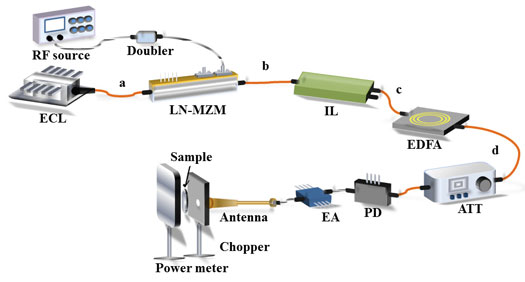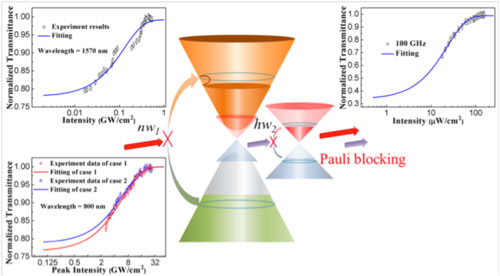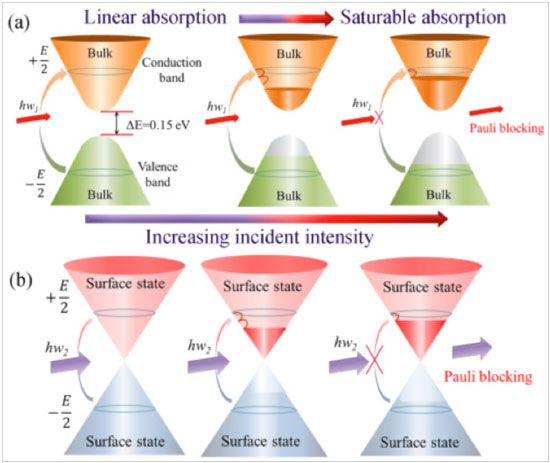| Posted: Apr 15, 2014 | |
Topological insulator - a novel optical and microwave-absorbing material |
|
| (Nanowerk Spotlight) In 2012, a Nanowerk Spotlight highlighted the broadband nonlinear optical response in graphene and predicted that a group of novel microwave devices may be developed from graphene (see: "The rise of graphene in microwave photonics"). | |
| Recently, another new Dirac material – a lattice system where the excitations are described by relativistic Dirac or Weyl equations – namely a topological insulator (TI), entered researchers' sight. TIs possess a small band gap in their bulk state and a gapless metallic state at their edge/surface. | |
| The surface states in topological insulators enable the transport of spin-polarized electrons while preventing "scattering" typically associated with power consumption, in which electrons deviate from their trajectory, resulting in dissipation. | |
| Besides their potential applications in next-generation electronic devices, given this unique dissipation-less electron population, topological insulators may also give rise to significant changes in photonics. | |
| As expected, graphene-based devices, such as photodetector, broadband optical modulator and polarizer, have been successfully developed. Given the similarities between graphene and TI, some interesting fundamental questions arise: Whether TI can find applications in many photonic devices? Whether TI shows similar nonlinear microwave and optical response as graphene? Whether TI could result in microwave and optical devices? | |
| Now, a Chinese research group working on two-dimensional materials photonics led by Professor Han Zhang and Shuangchun Wen, both from Hunan University, experimentally demonstrated for the first time that TI may be a novel microwave-absorbing material. | |
| The new findings, reported in a recent issue of Optical Materials Express ("Broadband optical and microwave nonlinear response in topological insulator"), show broadband saturable absorption features at optical band, and even the microwave and terahertz band. | |
 |
|
| Fig. 1: Schematic of the microwave generation and saturable absorption measurement. (© OSA) | |
| In their experiment, the researchers employed optical frequency multiplication to ensure high-quality microwave/terahertz signals. By changing the RF clock source, the frequency of mm-wave can be tuned and a microwave frequency tuned from 96 GHz to 100 GHz was achieved. The microwave power was controlled by adjusting the attenuator from 20 µW to 500 µW, which therefore makes the output microwave power widely adjustable, and microwave transmittance in TI can be measured under various microwave power levels. | |
| Experimental results showed that the normalized modulation depth and saturation intensity are ~70% and ~10 µW/cm2 at 100 GHz frequency. And the Z-scan measurement was utilized to investigate the saturable absorption property of the TI at optical band. The same TI sample shows saturable absorption response at 800 nm and 1570 nm with saturable intensity of 6.02 GW/cm2 and 0.13 GW/cm2, and modulation depth of 23.5% and 21%, respectively. | |
 |
|
| Fig. 2: Saturable absorption curves and the schematic of two kinds of saturable absorption mechanisms in topological insulator: from surface state and bulk state. (© OSA) (click image to enlarge) | |
| In view of the fact that the TI has gapless metallic surface states, electrons at the surface states could play an important role in the absorption of microwave photon that lies within the absorption band of the surface metallic state. Thus, the Dirac-cone surface states of TI endow the absorption of microwave photons at an arbitrary frequency around 100 GHz. | |
| Consequently, Zhang argues that determined by the unique electronic property in topological insulator, there are two different types of saturable absorption mechanisms that could account for the experimentally observed optical and microwave saturable absorption feature, respectively. That is, the bulk insulating state results in the optical saturable absorption while the surface metallic state is responsible for the saturable absorption at microwave band. | |
| This suggests that topological insulator possesses more complicated saturable absorption mechanisms than graphene, particularly because of its non-trivial surface and bulk state. | |
| This new saturable absorption mechanism owing to the surface state is intriguing and upon further investigations may trigger other new applications by manipulating electrons in the surface state. | |
| However, there remains unknown physics behind this new type of microwave absorbing material, particularly on the relation between the polarization-state of the absorbing microwave photon and the spin-polarization of the Dirac electrons in the surface state. We hope that more researchers may pay more attention to this interesting point. | |
 |
|
| Fig. 3: Mechanism of the nonlinear optical response in topological insulator at the (a) optical and (b) microwave frequency. (© OSA) | |
| Besides graphene and topological insulator, Prof. Sun Zhipei, a laser expert from Aalto University, also summarizes in a recent review paper ("Solution processing of graphene, topological insulators and other 2d crystals for ultrafast photonics") that other 2-dimensional crystals – such as MoS2 – may show broadband saturable absorption response and have potential applications for ultra-fast photonics. | |
| Prof. Zhipei observes that topological insulator is not only a broadband nonlinear optical material but may also be a new microwave optical material. He anticipates that researchers from the optical and microwave community may like to explore the potential applications of TI, opening the way towards the exploration of some special and novel TI-based optical devices, such as passive mode-locker, Q-switcher, optical limiter and so on. | |
| Beyond its optical counterpart, being a new microwave absorbing material, topological insulator can provide fresh insights towards many civil and military applications, such as microwave communications, signal processing and data protection, electromagnetic interference shielding, cloaking, and stealth coating in military jets, and many more. | |
|
By Mursal Ashrafi and Qiaoliang Bao, Department of Materials Engineering, Monash University and Institute of Functional Nano & Soft Materials (FUNSOM), Soochow University
|
|
|
Become a Spotlight guest author! Join our large and growing group of guest contributors. Have you just published a scientific paper or have other exciting developments to share with the nanotechnology community? Here is how to publish on nanowerk.com. |
|
